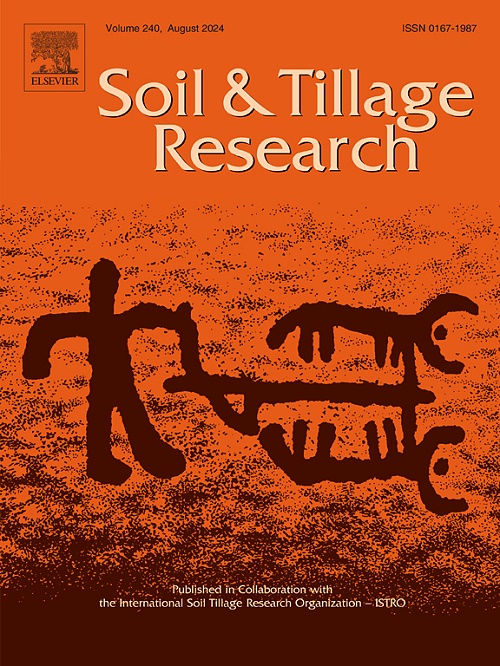Spatiotemporal changes of soil organic carbon in intensive croplands over three decades: Emerging role of farmland utilization shifts
IF 6.1
1区 农林科学
Q1 SOIL SCIENCE
引用次数: 0
Abstract
Understanding spatiotemporal variation characteristics and key driving factors of soil organic carbon (SOC) is crucial for refined managements of farmland quality and carbon emissions. Nevertheless, the impact of human-induced farmland utilization activities on regional SOC dynamics remains unclear. In this study, based on 1577 farmland topsoil (0–20 cm) samples, we developed a two-tiered stratification-contextualized framework within digital soil mapping paradigm for determining the drivers for spatiotemporal SOC dynamics by partitioning farmland and constructing individual machine learning method within farmland units (FUs) in East China during the 1980s-2010s, and then estimated spatiotemporal patterns of SOC as well as evaluated drivers on SOC changes within FUs using random forest models. Our results showed that the temporal changes in topsoil SOC stocks exhibited high spatial heterogeneity across three decades. The average SOC densities for the 1980s, 2000s, and 2010s were 41.4 ± 9.3 C ha−1, 47.4 ± 8.6 C ha−1 and 39.7 ± 14.4 C ha−1, respectively, with SOC densities initially increasing and then decreasing in our intensively cultivated region. Climatic changes accounted for > 75 % of the relative importance (RI) to SOC dynamics over the past 30 years. Farmland utilization shifts accelerated temporal SOC changes, with the effects coefficient increasing from 2.6 % (95 % CI: 1.7∼3.1 %) to 6.4 % (95 % CI: 3.9∼7.4 %). Induced by farmland utilization shifts, the overall changes of SOC stock increased by 0.10 Mt C during the 1980s-2000s with minimal SOC changes in FU3 and parts of FU1 (only 1 %), while decreased by 0.33 Mt C during the 2000s-2010s with approximately 12.9 % of regions in FU3, FU5, FU1 and FU6 exhibiting changes over 3 %. This work enhanced the understanding of spatiotemporal SOC variability induced by farmland utilization using machine learning method based on determined FUs, which also provided valuable guidance for soil monitoring and carbon accounting management for intensively cultivated farmland.
集约化耕地近30年土壤有机碳的时空变化:耕地利用转变的新作用
了解土壤有机碳(SOC)的时空变化特征及其关键驱动因素对农田质量和碳排放的精细化管理具有重要意义。然而,人类耕地利用活动对区域有机碳动态的影响尚不清楚。本研究基于1577个农田表层土壤(0-20 cm)样本,在数字土壤制图范式下,通过划分农田和构建农田单元(FUs)内的个体机器学习方法,建立了双层分层-情境化框架,以确定土壤有机碳时空动态的驱动因素。在此基础上,利用随机森林模型估算了土壤有机碳的时空格局,并评价了土壤有机碳变化的驱动因素。结果表明,30 a来表层土壤有机碳储量的变化具有高度的空间异质性。的平均有机碳密度1980年代,2000年代和2010年代41.4 ±9.3 C ha−1, 47.4±8.6 C ha−1和39.7 ±14.4 C ha−1,分别与SOC密度最初在我们的精耕细作地区增加然后减少。近30年来,气候变化对土壤有机碳动态的相对重要性(RI)占>; 75 %。农田利用变化加速了土壤有机碳的时间变化,影响系数从2.6 %(95 % CI: 1.7 ~ 3.1 %)增加到6.4 %(95 % CI: 3.9 ~ 7.4 %)。在农田利用变化的诱导下,20世纪80年代至21世纪初,土壤有机碳储量的总体变化增加了0.10 Mt C,其中FU3和部分FU1的有机碳变化最小(仅为1 %),而在2000年至2010年期间,土壤有机碳储量的变化减少了0.33 Mt C,其中FU3、FU5、FU1和FU6中约12.9 %的区域的变化超过了3 %。本研究利用基于确定傅立叶面积的机器学习方法增强了对农田利用引起的土壤有机碳时空变化的认识,为集约化耕地土壤监测和碳核算管理提供了有价值的指导。
本文章由计算机程序翻译,如有差异,请以英文原文为准。
求助全文
约1分钟内获得全文
求助全文
来源期刊

Soil & Tillage Research
农林科学-土壤科学
CiteScore
13.00
自引率
6.20%
发文量
266
审稿时长
5 months
期刊介绍:
Soil & Tillage Research examines the physical, chemical and biological changes in the soil caused by tillage and field traffic. Manuscripts will be considered on aspects of soil science, physics, technology, mechanization and applied engineering for a sustainable balance among productivity, environmental quality and profitability. The following are examples of suitable topics within the scope of the journal of Soil and Tillage Research:
The agricultural and biosystems engineering associated with tillage (including no-tillage, reduced-tillage and direct drilling), irrigation and drainage, crops and crop rotations, fertilization, rehabilitation of mine spoils and processes used to modify soils. Soil change effects on establishment and yield of crops, growth of plants and roots, structure and erosion of soil, cycling of carbon and nutrients, greenhouse gas emissions, leaching, runoff and other processes that affect environmental quality. Characterization or modeling of tillage and field traffic responses, soil, climate, or topographic effects, soil deformation processes, tillage tools, traction devices, energy requirements, economics, surface and subsurface water quality effects, tillage effects on weed, pest and disease control, and their interactions.
 求助内容:
求助内容: 应助结果提醒方式:
应助结果提醒方式:


